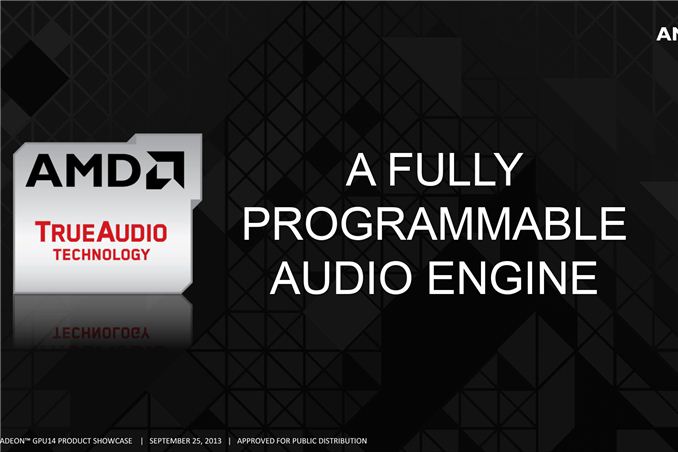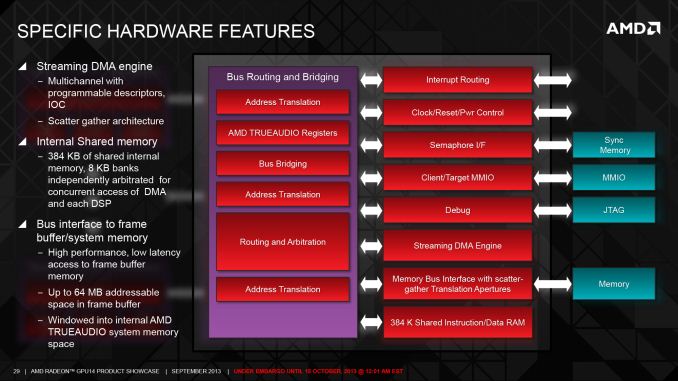PS4 Spec Update: Audio DSP Is Based On AMD’s TrueAudio
by Ryan Smith on November 13, 2013 3:07 PM EST- Posted in
- GPUs
- AMD
- Audio
- PlayStation
- TrueAudio

Continuing our coverage of AMD’s APU13 conference, one of this morning’s keynotes has been from Sony’s VP of Research & Development in North America, Dominic Mallinson. Most of Dominic’s presentation was a recap of the PS4 thus far – including some detail in why Sony went with an AMD APU for the console – but Dominic did throw in one more piece of information on the PS4’s specifications that we haven’t heard before. Specifically, the PS4’s audio DSP is based on AMD’s TrueAudio technology.
Briefly, from a console-centric view this isn’t of great surprise. We’ve had every reason to believe that the PS4’s audio DSP would have similar capabilities to TrueAudio given the features and low die space cost of today’s audio DSPs, coupled with Sony’s previous comments on the matter. So from that perspective this isn’t a significant revelation as far as the PS4’s audio capabilities are concerned, but we do finally have a bit more detail on the underlying hardware powering it.
But from a PC perspective however, this is going to be more important and unexpected news. At this time we don’t know what the underlying API is like – AMD hasn’t even released the TrueAudio PC API yet – but the shared hardware is going to be a big deal for both AMD’s CPUs and APUs. One of the challenges we discussed as facing TrueAudio is developer adoption; AMD has to convince developers to take the time to program for TrueAudio along with more traditional CPU sound engines. AMD has been working with audio middleware developers to help bootstrap TrueAudio adoption, but today’s announcement would take that one step further.
PS4 utilizing TrueAudio means there will be at least some level of audio engine portability between the PS4 and current generation AMD products. To that end if developers can write high quality audio engines on the PS4 thanks to the presence of the dedicated audio DSP, and then take that audio engine and bring it to the PC to run on GPU/APU TrueAudio DSPs, then that provides a further avenue for bootstrapping TrueAudio usage in games. So much like Mantle in the graphics space, a shared console connection for TrueAudio in the audio space would allow for AMD to leverage their console connection to both allow better/easier porting from consoles, and to achieve the critical mass necessary to make tapping these low-level hardware features viable and worthwhile for a wider pool of developers.
That said, AMD isn’t promoting TrueAudio as a console porting solution right now like they have been Mantle, but the potential is there if AMD and developers seek to exploit it. Which if nothing else makes TrueAudio all the more worth keeping an eye on over the next year, as solving the bootstrap/adoption issue will be a critical factor in the technology’s success. On that note, according to AMD’s latest schedule Thief is still expected to be the PC TrueAudio launch title, so we should be getting to see the first fruits of AMD’s labor here in February.


















43 Comments
View All Comments
Sabresiberian - Tuesday, November 19, 2013 - link
I have no interest in TrueAudio at this point. If it turns out to be a better solution than the latest mainboard solutions that have come out recently, or is better than a discreet sound card, it might be a plus in my book, otherwise I'll never care about it. Frankly I'd rather they drop the whole sound thing from their video cards and spend the money on making them better graphics solutions.It makes sense in terms of small form factors using an SoC, but for builds requiring discreet graphics cards - not so much. A console is about as useful as it will get.
AMD's domination of the console market will have no effect at all on the PC.
andy o - Wednesday, November 13, 2013 - link
The Tech Report in their 260X review said that AMD said True Audio is coming to the 7790 as well via drivers, can this be confirmed?Ryan Smith - Wednesday, November 13, 2013 - link
Yes.andy o - Wednesday, November 13, 2013 - link
Great, just got one. Thanks!Communism - Wednesday, November 13, 2013 - link
Anyone know why the Xbox One is not using the same TrueAudio DSP?Ryan Smith - Wednesday, November 13, 2013 - link
We don't know what it's using period. It could very well be the same thing and we'd never know.Alexvrb - Wednesday, November 13, 2013 - link
We don't?? That's the first thing I noticed missing when I opened this article. I'm pretty sure it's been confirmed that the Xbox One's SHAPE is also integrating Tensilica DSPs. You should probably fire up a search engine and punch in stuff like... Tensilica. Xbox One. Things like that. :PAnyway, SHAPE also has other additional hardware - low-latency low-power stuff to offload for Kinect, for one. Also possibly to help offload for multitasking (snapping video or audio for example) by accelerating decoding, etc.
tipoo - Wednesday, November 13, 2013 - link
I've read the PS4 DSP can handle 250 voices while the XBO does 500, beyond Kinect decoding does this matter? Anyone? Ryan?wrkingclass_hero - Wednesday, November 13, 2013 - link
I've heard that as well. I would also be interested to know how the PS4's audio stacks up against the XBOX 360, because I have read before that it supported 300 voices.ol1bit - Thursday, November 14, 2013 - link
I think my XBOX 360 surround sound sucks, compared with my basic blu-ray player. so I hope ps4 is better that that.